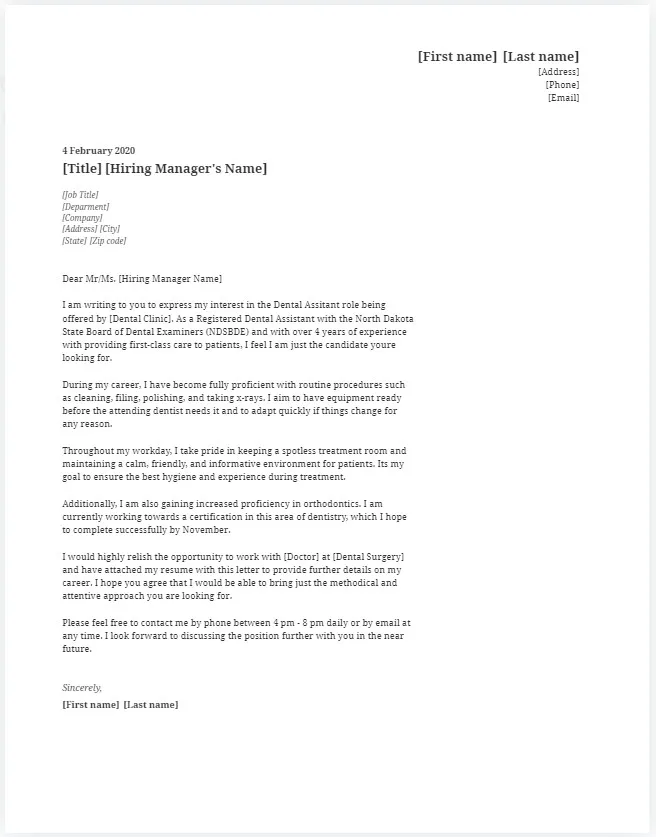Crafting a Winning Dental Assistant Cover Letter
A well-crafted cover letter is your first chance to make a lasting impression on a potential employer in the competitive field of dental assisting. It’s not just a formality; it’s a crucial tool that allows you to introduce yourself, showcase your skills, and highlight your qualifications in a way that a resume alone cannot. This section explores the fundamentals of creating a cover letter that grabs attention and sets you apart from other applicants. By understanding the core elements of a strong cover letter, you can significantly increase your chances of securing an interview and ultimately, landing your dream job in the dental field. Remember, your cover letter is a reflection of your professionalism, attention to detail, and genuine interest in the position.
Highlighting Your Dental Skills and Experience
Your cover letter is the perfect place to showcase your practical skills and hands-on experience. Instead of simply listing your responsibilities, describe your accomplishments and how you’ve contributed to previous dental practices. Quantify your achievements whenever possible; for example, mention the number of patients you assisted daily or how you improved efficiency in the sterilization process. Highlight your proficiency in taking and processing X-rays, assisting with various dental procedures (fillings, extractions, etc.), and educating patients on oral hygiene. Mention any specialized skills, such as experience with specific dental software or equipment. By providing concrete examples of your abilities, you demonstrate your value to potential employers and make it clear that you can hit the ground running. Remember to tailor your examples to match the specific requirements of the job description.
Education and Certifications Section
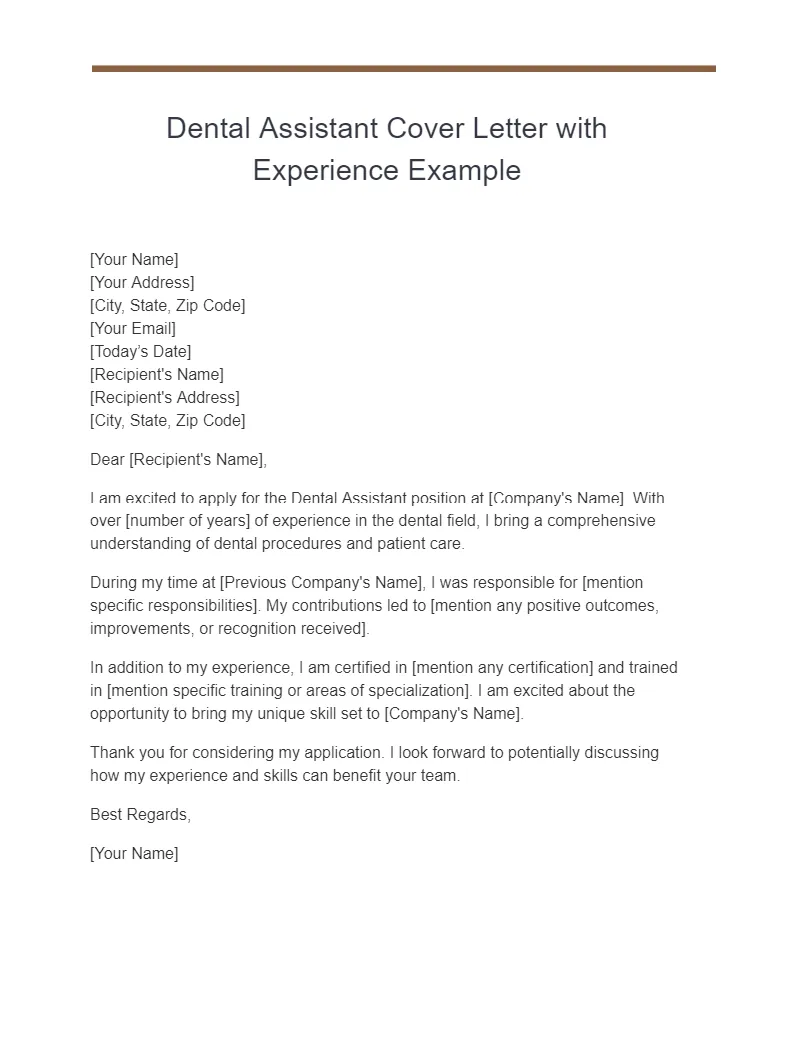
Include a dedicated section detailing your educational background and certifications. Mention the name of your dental assisting program, the institution you attended, and the date of your graduation. If you have any relevant certifications, such as Certified Dental Assistant (CDA) or Registered Dental Assistant (RDA), be sure to include those as well. List the specific areas you were trained in, such as coronal polishing, applying sealants, or taking impressions. This section gives employers a quick overview of your formal training and credentials, verifying that you have the necessary qualifications to perform the job duties. Consider adding any continuing education courses or workshops you’ve completed to show your commitment to staying updated with the latest advancements in dental assisting. This demonstrates your dedication to providing high-quality patient care and maintaining professional competence.
Professional Certifications
Certifications are a vital aspect of your dental assisting profile. The Certified Dental Assistant (CDA) credential, awarded by the Dental Assisting National Board (DANB), is a widely recognized and highly valued certification. Similarly, a Registered Dental Assistant (RDA) designation, which requirements vary by state, signifies that you meet your state’s requirements to practice. Clearly state your certifications within your cover letter. Include the certification name, the issuing body, and, if applicable, the date of certification or the expiration date. If you’re currently working toward a certification, mention that as well, indicating the anticipated completion date. Certifications not only validate your knowledge and skills but also reassure employers that you adhere to the highest professional standards. Highlighting your certifications indicates your commitment to ongoing professional development and your adherence to the ethical guidelines of the dental assisting profession. Consider listing any additional specialized training or certifications, such as CPR certification or certifications related to specific dental software or equipment.
Essential Dental Assistant Skills
Dental assisting demands a unique blend of technical and interpersonal skills. In your cover letter, emphasize these critical skills to show potential employers that you’re well-rounded and prepared for the role. Focus on skills such as assisting dentists during procedures, taking and developing X-rays, preparing dental instruments and equipment, and managing patient records. Highlight your proficiency in taking patient histories, providing chairside assistance, and ensuring patient comfort. If you have experience with specific dental software or equipment, such as electronic health records (EHR) systems or digital X-ray technology, mention those skills. Demonstrating that you possess these essential skills indicates that you can efficiently perform the core functions of a dental assistant. Remember to use keywords from the job description and tailor your skills to match the specific requirements of the position.
Communication and Interpersonal Skills
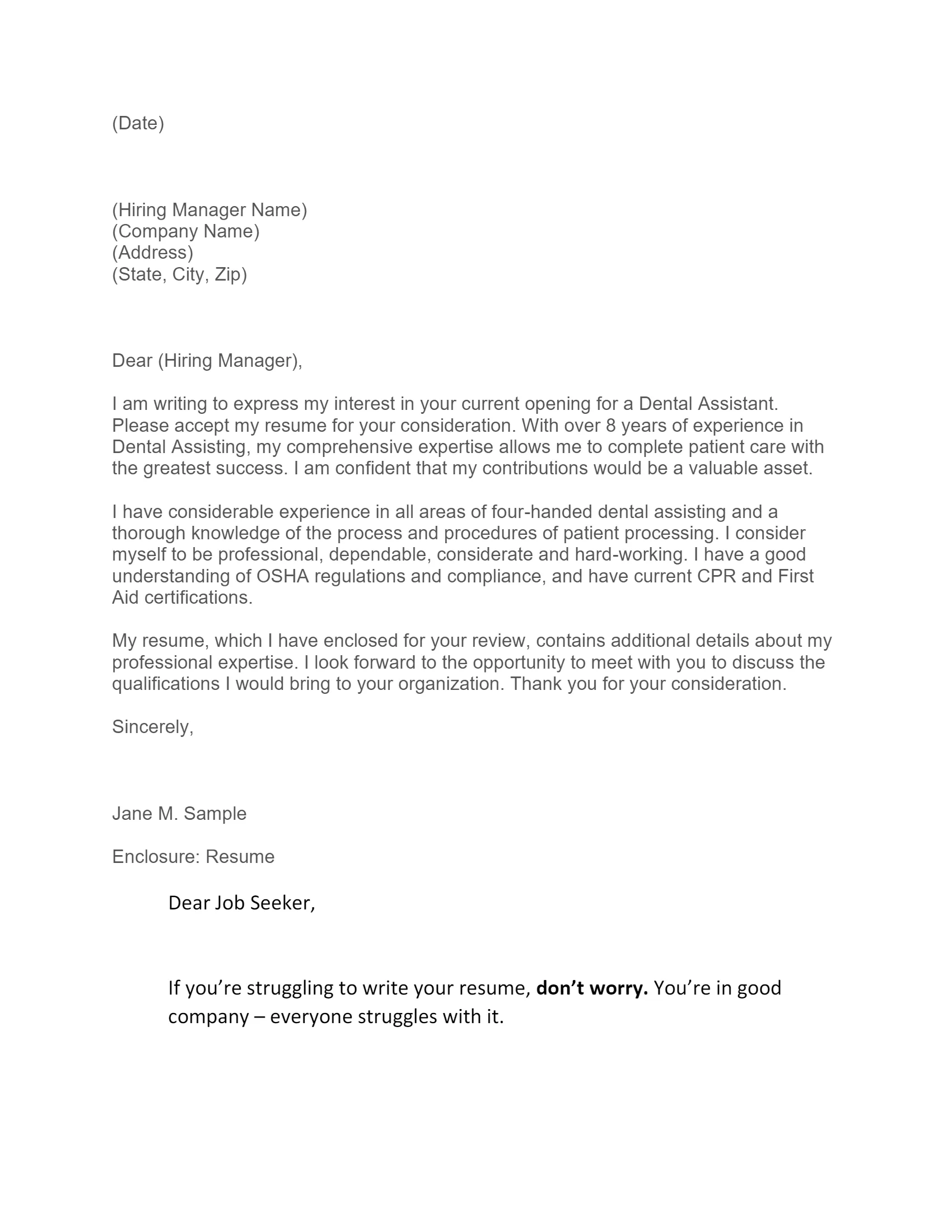
Dental assistants are at the forefront of patient interaction. Highlight your exceptional communication and interpersonal skills. Mention your ability to clearly explain dental procedures to patients, alleviate their anxieties, and build rapport. Emphasize your experience in handling patient inquiries, managing appointment schedules, and ensuring a positive patient experience. Showcase your teamwork capabilities, indicating your ability to collaborate effectively with dentists, hygienists, and other staff members. Provide examples of your active listening skills and your ability to adapt your communication style to suit different personalities and situations. Highlight any experience in conflict resolution or managing difficult patient situations. Demonstrate your ability to create a welcoming and comfortable environment for patients is key to your success.
Technical Skills in Dentistry
Beyond interpersonal skills, dental assistants need a solid foundation of technical knowledge. Detail your specific technical skills, such as taking and developing dental X-rays, preparing and sterilizing instruments, and assisting with various dental procedures. Highlight your proficiency in mixing dental materials, taking impressions, and applying topical anesthetics and sealants. Include details on any experience with specialized equipment like digital X-ray systems, intraoral cameras, or CAD/CAM technology. Show your ability to follow infection control protocols and maintain a clean and organized operatory. Mention any experience with electronic health records (EHR) or practice management software. By demonstrating these technical abilities, you reassure potential employers that you are proficient in the daily operational requirements of a dental practice.
Showcasing Your Enthusiasm and Passion
Your cover letter should be more than just a list of your skills and experience; it’s an opportunity to express your passion for dental assisting. Share what excites you about the profession and why you chose it as a career. Highlight your commitment to providing excellent patient care, staying current with industry trends, and contributing to a positive work environment. Mention any experiences or events that fueled your passion for dentistry. Express your eagerness to learn and grow within the practice, emphasizing your willingness to take on new challenges and responsibilities. Let your enthusiasm shine through; it will make a memorable impression and demonstrate that you are not just looking for a job but are also genuinely committed to a career in dental assisting. Mention specific dental practices or areas of dentistry that particularly interest you, this will demonstrate that you are committed and informed.
Why You’re a Perfect Fit for the Role
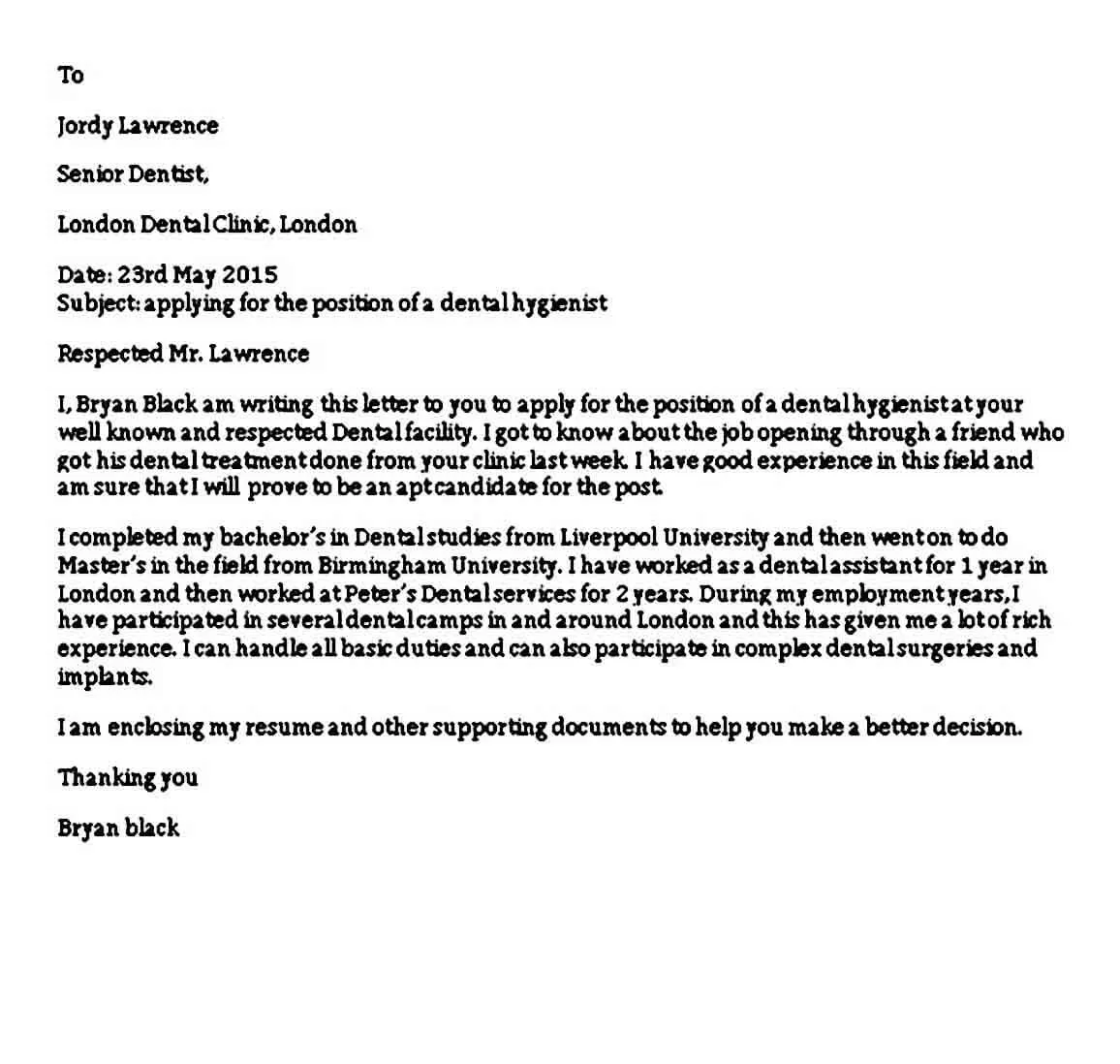
Your cover letter’s effectiveness hinges on demonstrating why you’re the ideal candidate for the specific role. Carefully review the job description and identify the key skills and qualifications the employer is seeking. Tailor your letter to address these requirements directly. Explain how your skills, experience, and qualifications align with what the practice is looking for. Provide specific examples of how your past experiences have prepared you to excel in this position. If the job description mentions specific software, procedures, or patient populations, highlight any relevant experience you possess. Demonstrate your understanding of the practice’s mission and values, and explain why you believe you would be a good fit for their team. By making it clear that you’ve researched the position and understand the employer’s needs, you show that you’re genuinely interested and capable of fulfilling the role.
Addressing the Employer’s Needs
Go beyond simply listing your accomplishments and explain how you can solve the employer’s problems or meet their specific needs. For example, if the practice is looking to improve patient satisfaction, highlight your communication skills and your ability to create a comfortable environment. If they’re focused on efficiency, emphasize your experience in streamlining office procedures or utilizing dental software. If the job description mentions specific challenges or goals, demonstrate how your skills and experience can help them achieve those. This shows that you’re not just interested in what the job can do for you, but you’re also thinking about how you can contribute to the success of the practice. This demonstrates your understanding of the dental practice’s goals and your willingness to contribute to their success.
Formatting and Structure for Success
A well-formatted cover letter is essential for making a positive impression. Ensure your letter is easy to read, well-organized, and free of grammatical errors. Use a professional font like Times New Roman, Arial, or Calibri, and maintain a consistent font size. Use standard margins and spacing, and keep your letter concise, ideally no more than one page. Use clear headings and subheadings to break up the text and make it easier for the reader to find the information they need. Proofread your letter carefully to catch any typos or grammatical errors. A clean and professional format shows that you pay attention to detail and take the application process seriously, increasing the chances of your cover letter being read carefully.
Header and Contact Information
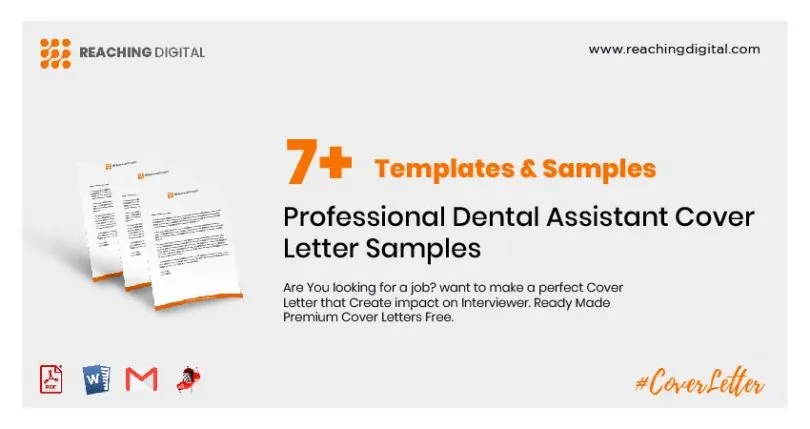
The header is the first thing a potential employer sees. Begin with your name, address, phone number, and email address at the top left or right of the page. If you have a professional online presence, such as a LinkedIn profile, include a link. Below your contact information, include the date and the employer’s contact information. Address the letter to the hiring manager or the dentist, if possible. If you are unsure of the hiring manager’s name, research the practice online or call to inquire. Addressing the letter to a specific individual demonstrates that you have taken the time to learn more about the practice and that you are proactive in your job search.
Professional Salutations
The salutation sets the tone for your entire cover letter. Start with a professional greeting. “Dear Mr./Ms./Dr. [Last Name]” is a standard and respectful approach. If you don’t know the hiring manager’s name, use “Dear Hiring Manager” or “Dear [Practice Name] Team.” Avoid generic greetings like “To Whom It May Concern.” Always use a formal and respectful tone. The salutation reflects your professionalism and attention to detail. Make sure the salutation matches the level of formality of the practice. A well-chosen salutation sets a positive tone for the rest of your letter, ensuring that it is received professionally.
Body Paragraphs that Impress
The body paragraphs are where you showcase your skills, experience, and passion. Begin with a strong opening paragraph that states the position you are applying for and where you learned about the opportunity. The subsequent paragraphs should highlight your relevant skills, experience, and accomplishments, backed by specific examples. Use the job description as a guide, tailoring your content to match the employer’s needs. Each paragraph should focus on a specific aspect of your qualifications, allowing you to elaborate and provide detailed examples. Use action verbs to describe your accomplishments and avoid generic statements. Quantify your achievements whenever possible to provide a clear picture of your value. Ensure that your writing is clear, concise, and engaging. The body paragraphs are your opportunity to persuade the employer that you are the perfect fit for the role.
Closing Your Cover Letter Effectively
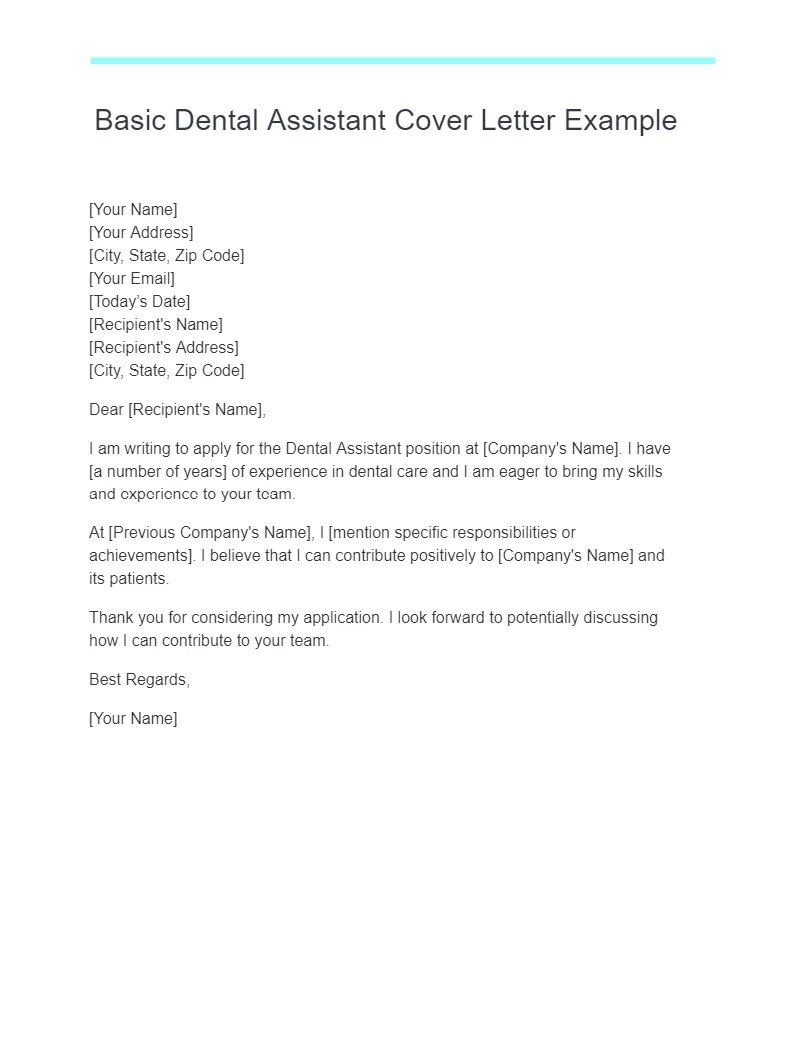
The closing paragraph should summarize your key qualifications and reiterate your interest in the position. Express your enthusiasm for the opportunity and reiterate your desire to contribute to the practice’s success. End with a clear call to action, such as requesting an interview. Be sure to thank the employer for their time and consideration. Reiterate your contact information, making it easy for them to reach you. Conclude with a professional closing, such as “Sincerely” or “Respectfully,” followed by your full name. Ensure the tone of your closing reflects your enthusiasm and professionalism. An effective closing paragraph leaves a lasting positive impression.
Proofreading and Polishing Your Letter
Before you submit your cover letter, carefully proofread it for any errors in grammar, spelling, and punctuation. These mistakes can undermine your credibility and make a negative impression on the employer. Read your letter aloud to catch any awkward phrasing or unclear sentences. If possible, ask a friend, family member, or career counselor to review your letter for feedback. Make sure the formatting is consistent, and the font is legible. Ensure the content is tailored to the specific job description and the employer’s needs. Proofreading is crucial for demonstrating your attention to detail and commitment to presenting yourself professionally. A polished cover letter is a crucial step to leave a good impression and get your foot in the door for an interview.
